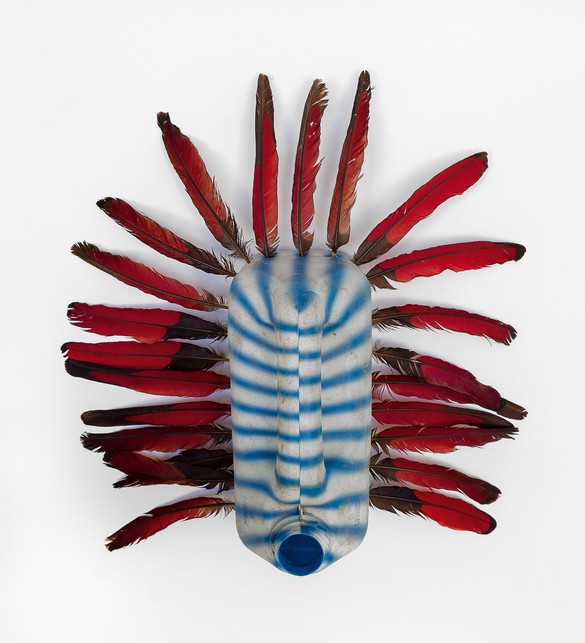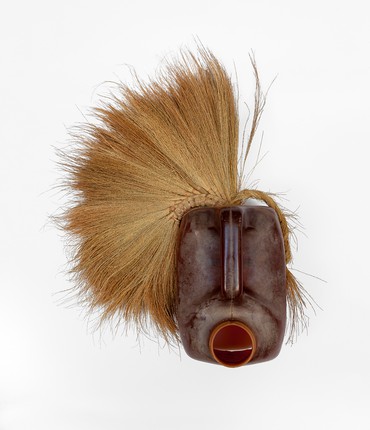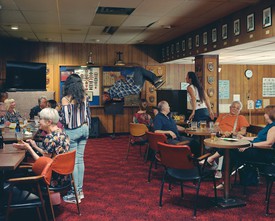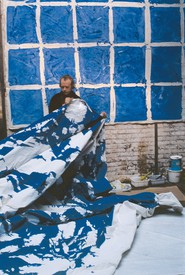
André Magnin is an independent curator and researcher of non-Western cultures. He worked on Hubert Martin’s exhibition Magiciens de la Terre (1989). From 1989 until 2009, Magnin ran the Pigozzi Collection, Geneva, which focused on sub-Saharan African contemporary art. He later founded MAGNIN-A, which promotes contemporary African art within the international market. Photo: Malick Sidibé
Romuald Hazoumè is an artiste engagé, an artist who takes a position. His work is deeply rooted in the cultural, social, and political context of Benin, but more generally of Africa and the world. An African artist, he is a cosmopolitan who embraces the globe.
Hazoumè has been crossing borders for almost thirty years. Recognizable by his kepi, a military hat covered with badges, like that of a soldier who has performed distinguished service, he is a man of imposing presence. In Benin he is a public figure, not only through his work as an artist but because he speaks loud and clear about what he thinks, taking stances and sharing sharp opinions. Hazoumè wants Africans to regain self-respect, wants to restore their dignity. He honors street children, his “powerful mongo heroes,” who participate in Benin’s economy by trafficking oil between the country’s capital, Porto-Novo, and neighboring Nigeria, the continent’s largest oil producer. Hazoumè, his life, his struggles, his work—a whole big story! He speaks several languages including Goun, his native tongue; Yoruba, because of his Nigerian origins; and also Fon, Mina, Mahi, Adja, Ewè, Nagot, Ouémé, Tori, and others among the fifty-five languages spoken by the people of Benin.
For a long time it was said that the word, the concept, of art did not exist in Africa. Was that ignorance or contempt? Art emerged in Africa more than seven thousand years ago. Hazoumè knows where he comes from and consciously and proudly carries on the tradition of the ares, the itinerant artists of Benin’s royal period who carried culture from kingdom to kingdom, leaving examples for future ares as they passed through. The great palaces were decorated by the ares. The donkeys and oxen that carried their forges and anvils, tools and looms, have today been replaced by cars, trains, and planes. That is the way of the contemporary itinerant, and, Hazoumè says, “I am a contemporary are.”
Hazoumè, originally Yoruba, was raised in a Catholic family, but he maintained a relationship with ancestral worship and was profoundly influenced by West African Vodun. As a boy he began using salvaged materials to make masks for Kaleta, the festival of games and masks so cherished by Benin children. After high school he turned to painting and sculpture, notably using salvaged bidons, plastic jerry cans, which he minimally modified to turn them into masks that subtly reveal his critical view of African politics. He wore his first mask made from a jerry can in 1986; it established his reputation. Hazoumè has been described as the “bidon artist.”
I met Hazoumè in 1988, in Cotonou. From the road I had noticed a small crowd outside a hall lit by neon. The assemblages of recycled materials that I discovered hanging on the wall inside looked like nothing I had seen in Africa before. Often filled with contraband gasoline and sold on the black market along the side of the road, those ordinary plastic jerry cans had lost their function, their history; in their new context, on the other side of the road, they had become works of art, “assisted readymades”: Mon général (My general, 1992), L’inspirateur (The inspiration, 1992), Miss Abidjan (1992), Claudia (1999).
Hazoumè’s double cultural membership—Yoruba, or animist, and Catholic—generates an inner conflict that results in a syncretic process of creation: made out of contemporary, salvaged materials, the masks show links to Yoruba tradition. Hazoumè says he sees his masks “go out,” for example; for a mask to “go out,” explains the Malian scholar Youssouf Tata Clissé, is for it to “reiterate all the stages of creation.” In another example, a mask that plays an important role in a traditional Bambara ritual is the Tourbillon (whirlwind) mask, the figure of the primordial vortex that presided over the emergence of life. Hazoumè draws on this vocabulary of initiates in his Zanzibrrrrace mask (2003), using modern materials but maintaining that earlier character. His assemblages of scraps and disused objects, which he may use as is or may form and deform, are also representations of his vision of society, events, and world problems.
For a long time it was said that the word, the concept, of art did not exist in Africa. Was that ignorance or contempt?
Between Hazoumè’s introduction to the African mask tradition and now, when he has become, as he says, a contemporary itinerant, his part of the world has profoundly changed. The social and economic context has been overturned. The live show that unfurls in the streets of Cotonou and Porto-Novo reveals much about the lifestyle of the country, obsessed with its history at a time when Yoruba culture slips away a bit more every day. It is in that context that Hazoumè lives and wants to intervene.
In Porto-Novo, some dozen kilometers from the Nigerian border, the bidon, which is used to transport the contraband gas consumed by 90 percent of Beninese, has become a cult object: it’s a work tool, it represents an income, it’s an object of survival. Since gas is far more expensive in Benin than in the neighboring oil-producing nation of Nigeria, gangs from the Ouèmè valley became gas traffickers, eventually coming to hold a monopoly on this very profitable, very dangerous activity. A moped loaded with 100 liters of gas is a moving bomb. Each trafficker marks his bidons as slaves were once marked, a metaphor for the slavery of the past. Each bidon designates the religious affiliation of its owner, whether or not he is literate, and other information. “We die for oil,” says Hazoumè, “but without the trafficking and the work and the money it generates, the political situation would also be very explosive.”
Hazoumè draws from history, culture, belief, Vodun, the Fa divination system, and the vocabulary of initiates in these faiths as a way to make his work specific, all while producing an oeuvre that unabashedly reveals the madness of the current state of the world. The strongest art in Africa is undoubtedly art that attests to community concerns; Hazoumè’s sculptures, photographs, and installations are an example of this kind of art, as his people recognize and welcome. At the same time, the work is so immediately legible and recognizable beyond Benin that Hazoumè, propelling his local culture to an international level, can legitimately claim the role of worldwide itinerant are.
Hazoumè’s exhibition at Gagosian on Park Avenue in New York, opening in September 2018, will consist primarily of masks that evoke the fragility of vulnerable peoples who are oppressed or have become stateless. Oiseau bleu (Bluebird, 2018), for example, has a head of feathers as light as America’s consideration of Native American communities; Algoma (2016) is named after the Burmese who provided the artist with the horsehair broom that tops this mask, which pays homage to the Rohingya refugees, the Muslim community chased out of Myanmar. Hanging in space, the robe of a revenant’s costume made out of plastic, with undulating shapes like the whirlwind’s, symbolizes the expulsion of “bad spirits” that hector and weaken populations to the point of destruction.
Romuald Hazoumè, Gagosian, Park & 75, New York, September 5–October 13, 2018; artwork © 2019 Romuald Hazoumè and Artists Rights Society (ARS), New York/ADAGP, Paris; photos: Zarko Vijatovic; text translated from the French by Molly Stevens













